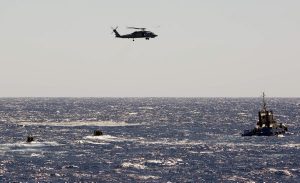On July 1 this year, Australia released a Defense Strategic Update along with a supporting Force Structure Plan, the former replacing strategic guidance provided in the 2016 Defense White Paper. Both documents come at a time when Canberra finds itself in Beijing’s crosshairs across a range of issues spanning economics and geopolitics. While pursuing policies independent of Washington’s stated preferences – over the South China Sea, or inquiry on the origins of the novel coronavirus – the Scott Morrison government remains fundamentally committed to the U.S.-Australia alliance and the strategic bet that entails.
At the same time, influential voices such as Hugh White, strategist and principal author of the 2000 Defense White Paper, have argued that it would be foolish for Australia to solely rely on its military relationship with the United States. White has exhorted Canberra to prepare for a world “without America” – a scenario where the United States is no longer either capable or willing to retain hegemony in Asia. In a recent book, he bluntly writes: “We are less sure now that America will remain the primary power in Asia, or that it will retain any major strategic role at all.”
The 2020 Defense Strategic Update is far from being accommodating toward this point of view. It categorically notes, for example, “Australia is a staunch and active ally of the United States, which continues to underwrite the security and stability of the Indo-Pacific.” That said, there are shades of White in it, with an observation that “habits of cooperation in the Indo-Pacific are being challenged, leading to uncertainty and complicating security partnerships.”
While noting that “[o]nly the nuclear and conventional capabilities of the United States can offer effective deterrence against the possibility of nuclear threats against Australia,” it goes on to say “it is the Government’s intent that Australia take greater responsibility for our own security. It is therefore essential that the ADF [Australian Defense Forces] grow its self-reliant ability to deliver deterrent effects.” (White in the past has gone much further and seriously examined the need for Australia to acquire an independent nuclear deterrent.)
The strategic goals that the document sets are expansive: “to shape Australia’s strategic environment; to deter actions against Australia’s interests; and to respond with credible military force, when required.” As a demonstration that Australia intends to walk the walk, the update also committed to spending of 575 billion Australian dollars (US$416.5 billion) over the next 10 years, through 2029-30. The supporting Force Structure is striking (pardon the pun), with a pronounced focus on long-range missile capabilities.
As The Diplomat’s Ankit Panda wrote last month, not only would these long-range conventional missiles significantly deter China from probing Australia’s immediate neighborhood, they could also be used to shape Beijing’s behavior in the South China Sea. In turn, these capabilities reduce Australia’s dependence on the United States and other allies; they would help prepare Australia for a world without the United States.
Strike capabilities are an essential component of an area denial capability, something the 2020 update notes. That said, for a maritime power keen on denying sea to an adversary’s surface fleet, submarines form another crucial component. Prospects for Australia’s future submarines fleet has been openly brought to question in the recent past. Analysts have also pointed out that the Force Structure Plan accompanying the update has left expenditure details around future maritime surveillance capabilities — yet another important piece of a sea denial strategy — unspecified.
But beyond issues around military hardware, where neither White nor the 2020 update seem to have any good answers to is when it comes to the question of deterring grey zone coercion – a set of activities, often a combination of covert, military and economic actions, through which an adversary seeks strategic gains without provoking all-out war. To be sure, the update recognizes the challenges posed by grey zone actions. It notes that: “[Australian Department of Defense] must be better prepared to respond to these activities, including by working more closely with other elements of Australia’s national power.”
Grey zone deterrence is the stuff of grand, and not military, strategy. Unfortunately, that is easier talked about than created. Exactly how to integrate economic sanctions with proportionate retaliatory military threats – and the exact “mix” – sufficient enough to deter or roll back grey zone actions, such as those undertaken by China in the South China Sea or Russia in Crimea in 2014, remains an open question.
Insofar as satisfactory solutions have been proposed to this problem (such as by Brookings’ Michael E. O’Hanlon in a recent book) it has been in the U.S. context, where Washington comes to the aid of an ally in Asia or Europe in face of a near-peer adversary’s actions. In turn, these solutions crucially depend on the unmatched capability of the United States to economically coerce other states. How middle powers like Australia (or India, for that matter) practice economic statecraft without necessarily seeking the help of a stronger ally or partner remains to be seen.
So: Are long-range strike systems and area denial capabilities necessary for Australia to deter creeping Chinese aggression in its sphere of interest? Yes. Are they sufficient? The answer is no.
































